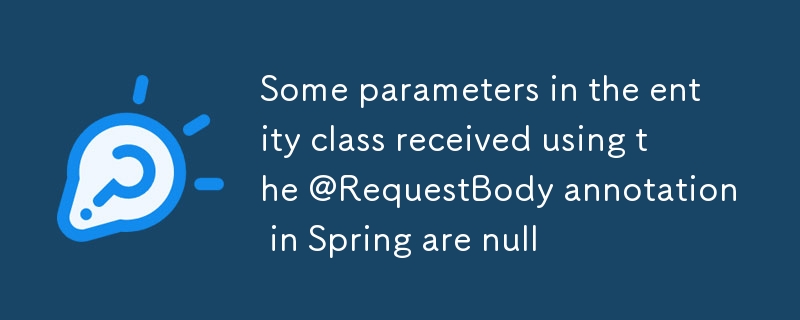 Common Problem
Common Problem
 Some parameters in the entity class received using the @RequestBody annotation in Spring are null
Some parameters in the entity class received using the @RequestBody annotation in Spring are null
Some parameters in the entity class received using the @RequestBody annotation in Spring are null
This article discusses how to ensure that all parameters in an entity class annotated with @RequestBody are non-null in Spring. It explains the default behavior of @RequestBody for null parameters and provides several options to handle null parameter

How to Ensure Non-Null Parameters in an Entity Class with @RequestBody in Spring?
To ensure that all parameters in an entity class annotated with @RequestBody are non-null, you can use the @NotNull annotation from the javax.validation package.@NotNull annotation from the javax.validation package.
import javax.validation.constraints.NotNull;
public class MyEntity {
@NotNull
private String name;
// Other fields
}When the @NotNull annotation is applied to a field, Spring Validation will automatically check if the field is non-null. If it is null, a ConstraintViolationException will be thrown.
How Does @RequestBody Handle Null Parameters?
By default, @RequestBody will bind a null value to a non-primitive field in the entity class. For example, if you have a field annotated with @RequestBody and the corresponding request parameter is null, the field will be set to null in the entity class.
How to Handle Null Parameters in Part of an Entity Class with @RequestBody?
You have several options to handle the situation when some parameters in an entity class with @RequestBody are null:
- Use default values: You can provide default values for null fields by using the
@DefaultValueannotation from thejavax.validationpackage.
import javax.validation.constraints.DefaultValue;
public class MyEntity {
@RequestBody
private String name;
@DefaultValue("unknown")
private String description;
// Other fields
}In this case, if the description parameter is null in the request, it will be set to "unknown" in the entity class.
- Use optional fields: You can declare optional fields in the entity class using the
Optionalwrapper class from thejava.utilpackage.
import java.util.Optional;
public class MyEntity {
@RequestBody
private String name;
private Optional<String> description;
// Other fields
}In this case, if the description parameter is null in the request, the description field in the entity class will be set to Optional.empty().
-
Custom handling: You can also write custom code in the controller method to handle null parameters. For example, you could throw a
BadRequestExceptionrrreee When the
@NotNull annotation is applied to a field, Spring Validation will automatically check if the field is non-null. If it is null, a ConstraintViolationException will be thrown.@RequestBody and the corresponding request parameter is null, the field will be set to null in the entity class.🎜🎜How to Handle Null Parameters in Part of an Entity Class with @RequestBody?🎜🎜You have several options to handle the situation when some parameters in an entity class with @RequestBody are null:🎜-
Use default values: You can provide default values for null fields by using the
@DefaultValueannotation from thejavax.validationpackage.🎜🎜rrreee🎜In this case, if thedescriptionparameter is null in the request, it will be set to "unknown" in the entity class.🎜-
Use optional fields: You can declare optional fields in the entity class using the
Optionalwrapper class from thejava.utilpackage.🎜🎜rrreee🎜In this case, if thedescriptionparameter is null in the request, thedescriptionfield in the entity class will be set toOptional.empty().🎜-
Custom handling: You can also write custom code in the controller method to handle null parameters. For example, you could throw a
BadRequestExceptionif any of the required parameters are null.🎜🎜
-
Custom handling: You can also write custom code in the controller method to handle null parameters. For example, you could throw a
-
Use optional fields: You can declare optional fields in the entity class using the
The above is the detailed content of Some parameters in the entity class received using the @RequestBody annotation in Spring are null. For more information, please follow other related articles on the PHP Chinese website!

Hot AI Tools

Undresser.AI Undress
AI-powered app for creating realistic nude photos

AI Clothes Remover
Online AI tool for removing clothes from photos.

Undress AI Tool
Undress images for free

Clothoff.io
AI clothes remover

AI Hentai Generator
Generate AI Hentai for free.

Hot Article

Hot Tools

Notepad++7.3.1
Easy-to-use and free code editor

SublimeText3 Chinese version
Chinese version, very easy to use

Zend Studio 13.0.1
Powerful PHP integrated development environment

Dreamweaver CS6
Visual web development tools

SublimeText3 Mac version
God-level code editing software (SublimeText3)

Hot Topics
 deepseek web version official entrance
Mar 12, 2025 pm 01:42 PM
deepseek web version official entrance
Mar 12, 2025 pm 01:42 PM
deepseek web version official entrance
 In-depth search deepseek official website entrance
Mar 12, 2025 pm 01:33 PM
In-depth search deepseek official website entrance
Mar 12, 2025 pm 01:33 PM
In-depth search deepseek official website entrance
 How to solve the problem of busy servers for deepseek
Mar 12, 2025 pm 01:39 PM
How to solve the problem of busy servers for deepseek
Mar 12, 2025 pm 01:39 PM
How to solve the problem of busy servers for deepseek




